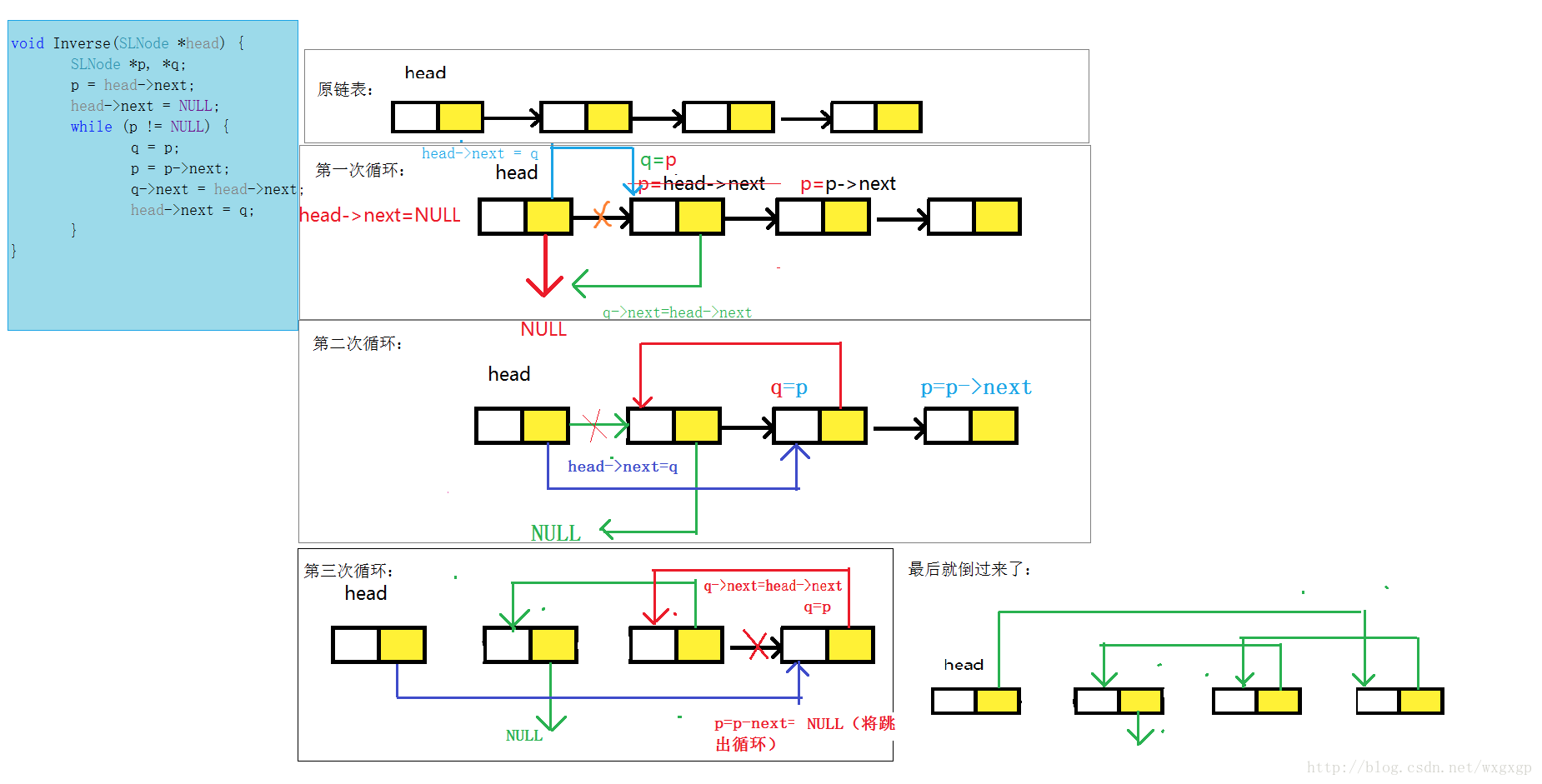python 链表
在C/C++中,通常采用“指针+结构体”来实现链表;而在Python中,则可以采用“引用+类”来实现链表。
节点类:
class Node:
def __init__(self, data):
self.data = data
self.next = None
链表类:
class Linkedlist:
def __init__(self):
self.head = None
self.tail = None
link_list = LinkedList()
def is_empty(self):
return self.head is None
def append(self, data):
node = Node(data)
if self.head is None:
self.head = node
self.tail = node
else:
self.tail.next = node
self.tail =node
def iter(self):
if not iter.head:
return
cur = self.head
yield cur.data
while cur.next:
cur = cur.next
yield cur.data
#先判断是不是空链表,yield head.data 再用while循环遍历
链表的头结点head 和 尾节点tail 都属于node.
insert:先将要插入的节点的next指向之后链表的head,然后将之前链表的next指向 将要插入的节点。
def insert(self, idx, value):
cur = self.head
cur_idx = 0
if cur is None:
raise Exception('That list is and empty list!')
while cur_idx < idx-1:
cur = cur.next
if cur is None:
raise Exception('List length less than index!')
cur_idx += 1
node = Node(value)
node.next = cur.next
cur.next = node
if node.next is None:
self.tail = node
def remove(self, idx):
cur = self.head
cur_idx = 0
#空指针
if self.head = None:
raise Exception('This is an empty list')
while cur_idx < idx-1:
cur = cur.next
#给出的索引大于链表的长度
if cur is None:
raise Exception('list length less than index')
cur_idx +=1
if idx == 0: #当删除第一个节点时
self.head = cur.next
cur = cur.next
return
if self.head is self.tail: #当只有一个节点时
self.head = None
self.tail = None
return
cur.next = cur.next.next
if cur.next is None: #当删除最后一个节点时
self.tail = cur
def size(self):
i = 0
cur = self.head
if current is None:
return 'The list is an empty list'
while cur.next is not None:
i +=1
cur = cur.next
return i
def search(self, item):
current = self.head
found = False
while current is not None and not found:
if current.data == item:
found = True
else:
current = current.next
return found
1,迭代
# -*- coding: utf-8 -*-
#!/bin/env python
# Python2.7 class Node(object):
def __init__(self):
self.value = None
self.next = None
def __str__(self):
return str(self.value) def reverse_list(head):
if not head or not head.next:
return head
pre = None
while head:
next = head.next # 缓存当前节点的向后指针,待下次迭代用
head.next = pre # 关键:把当前节点向前指针(pre)作为当前节点的向后指针
pre = head # 把当前指针赋值给 下次迭代 节点的 向前指针
head = next # 作为下次迭代时的(当前)节点
return pre # 返回头指针,头指针就是迭代最后一次的head(赋值给类pre) if __name__ == '__main__': three = Node()
three.value = 3 two = Node()
two.value = 2
two.next = three one = Node()
one.value = 1
one.next = two head = Node()
head.value = 0
head.next = one newhead = reverse_list(head)
while newhead:
print newhead.value
newhead = newhead.next
比较形象的图

2,递归
# 临界点:head.next为None
# 先递归到 把最后一个节点指向 newhead
# 然后一步步从后往前逆置 def reverse_recursion(head):
if not head or not head.next:
return head new_head = reverse_recursion(head.next) head.next.next = head
head.next = None
return new_head
python 链表的更多相关文章
- Python链表的实现与使用(单向链表与双向链表)
参考[易百教程]用Python实现链表及其功能 """ python链表的基本操作:节点.链表.增删改查 """ import sys cl ...
- Python链表操作(实现)
Python链表操作 在Python开发的面试中,我们经常会遇到关于链表操作的问题.链表作为一个非常经典的无序列表结构,也是一个开发工程师必须掌握的数据结构之一.在本文中,我将针对链表本身的数据结构特 ...
- python 链表表达式 map、filter易读版
链表推导式 [x for x in x] 链表推导式提供了一个创建链表的简单途径,无需使用 map(), filter() 以及 lambda.返回链表的定义通常要比创建这些链表更清晰.每一个链表推导 ...
- Python链表与反链表
# -*- coding:utf8 -*- #/usr/bin/env python class Node(object): def __init__(self, data, pnext = None ...
- python链表的实现
根据Problem Solving with Algorithms and Data Structures using Python 一书用python实现链表 书籍在线网址http://intera ...
- python链表的实现,有注释
class Node(): #node实现,每个node分为两部分:一部分含有链表元素,成数据域;另一部分为指针,指向下一个 __slots__=['_item' ...
- python 链表的反转
code #!/usr/bin/python # -*- coding: utf- -*- class ListNode: def __init__(self,x): self.val=x self. ...
- python 链表、堆、栈
简介 很多开发在开发中并没有过多的关注数据结构,当然我也是,因此,我写这篇文章就是想要带大家了解一下这些分别是什么东西. 链表 概念:数据随机存储,并且通过指针表示数据之间的逻辑关系的存储结构. 链表 ...
- Add Two Numbers(from leetcode python 链表)
给定两个非空链表来表示两个非负整数.位数按照逆序方式存储,它们的每个节点只存储单个数字.将两数相加返回一个新的链表. 你可以假设除了数字 0 之外,这两个数字都不会以零开头. 示例: 输入:(2 -& ...
随机推荐
- centos 安装Phpstorm
下载: http://www.jetbrains.com/phpstorm/download/#section=linux 解压: tar -zxf PhpStorm-8.0.1.tar.gz # 然 ...
- MySQL删除相同前缀的表,修改某个库的存储引擎
MySQL5.0 之后,提供了一个新的数据库information_schema,用来记录MySQL总的元数据信息.元数据指的是 数据的数据. 比如表名.列名.列类型.索引名等表的各种属性名称.这个库 ...
- JETSON TK1 ~ 基于eclipse下开发ROS
此文档是在PC端开发后移植到TK1,并非在TK1上安装eclipse 官方使用IDE开发的文档: http://wiki.ros.org/IDEs 一:安装eclipse 1.下载eclipse安装包 ...
- mysql sql语句:行转列问题
存在表score,记录学生的考试成绩,如下图所示: 现要求以 学生姓名,语文,数学,英语 这种格式显示学生成绩,如下图所示 具体步骤如下: 1.首先,使用case when函数输出单个课程的成绩 ca ...
- ubuntu 16.04 jenkins pipline的实现 最终docker启动服务
准备工作:两台虚拟机A:192.168.1.60 B:192.168.1.61 C:一个存放代码的代码库(github)A:jenkins git docker openssh-server(ssh) ...
- 【leetcode刷题笔记】Set Matrix Zeroes
Given a m x n matrix, if an element is 0, set its entire row and column to 0. Do it in place. 题解:因为题 ...
- Flask框架的学习与实战(三):登陆管理
继续flask的学习之旅.今天介绍flask的登陆管理模块,还记得上一篇中的blog小项目么,登录是咱们自己写的验证代码,大概有以下几个步骤: 1.在登录框中输入用户名和密码 2.flask view ...
- 0423 hashlib模块、logging模块、configparse模块、collections模块
一.hashlib模块补充 1,密文验证 import hashlib #引入模块 m =hashlib.md5() # 创建了一个md5算法的对象 m.update(b') print(m.hexd ...
- P3214 [HNOI2011]卡农
题目 P3214 [HNOI2011]卡农 在被一题容斥\(dp\)完虐之后,打算做一做集合容斥这类的题了 第一次深感HNOI的毒瘤(题做得太少了!!) 做法 求\([1,n]\)组成的集合中选\(m ...
- springmvc接受表单多条数据的值
点击下面链接查看具体内容: http://blog.csdn.net/lutinghuan/article/details/46820023
